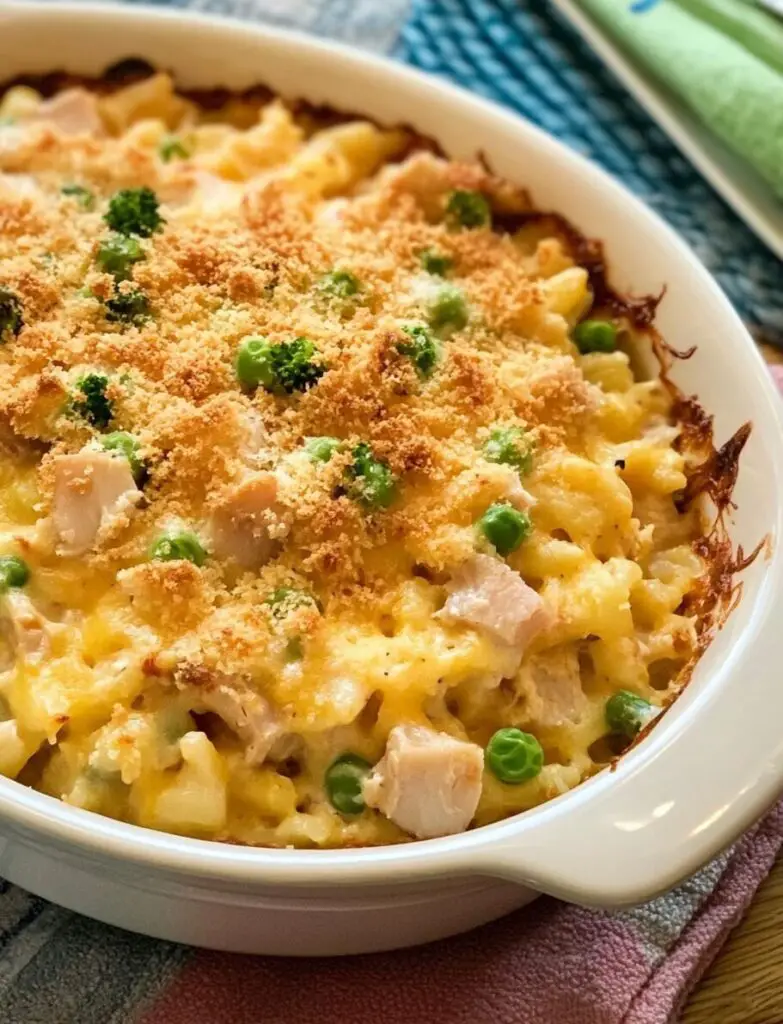Tuna casserole is a timeless dish known for its creamy, savory flavors and easy preparation. Originating in the mid-20th century, this comforting meal has been a staple in American households. With its affordability and nostalgic charm, it’s perfect for busy weeknight dinners, potlucks, or a cozy family meal.
Ingredients:
- 3 cups cooked egg noodles
- 1 can (10.75 oz) condensed cream of mushroom soup
- 1 cup shredded Cheddar cheese (divided)
- 1 can (5 oz) tuna, drained
- 1 cup frozen peas
- 1/4 cup crushed potato chips
Directions:
- Preheat Oven: Preheat your oven to 350°F (175°C).
- Prepare Noodles: Cook the egg noodles in salted water until al dente; then drain.
- Mix Ingredients: In a large bowl, combine the cooked noodles, cream of mushroom soup, 1 cup of shredded cheese, tuna, and frozen peas. Mix well.
- Transfer to Baking Dish: Pour the mixture into a 9×13 inch baking dish and spread it evenly.
- Add Toppings: Sprinkle the crushed potato chips and remaining cheese on top.
- Bake: Bake for 20–25 minutes, until the cheese is bubbly and the top is golden.
Nutrients (Per Serving):
- Calories: 250 kcal
- Protein: 12g
- Carbohydrates: 23g
- Fat: 10g
- Fiber: 2g
Enjoy this classic dish warm, and feel free to customize it with your favorite vegetables or cheeses for a personalized touch!
The Classic Tuna Casserole: A Timeless Comfort Food
Tuna casserole has earned its place in the annals of American cuisine as a beloved comfort dish, celebrated for its creamy texture, savory flavors, and satisfying simplicity. Its roots trace back to the mid-20th century when casseroles were emerging as a convenient and cost-effective way to feed families. Over the decades, this dish has evolved, maintaining its reputation as a versatile, customizable, and universally appealing meal. Let’s explore the story behind tuna casserole, why it remains a household favorite, and how you can adapt it to suit your tastes and dietary needs.
The Origins of Tuna Casserole
The concept of combining ingredients in a casserole dish dates back centuries, but tuna casserole as we know it today took shape in the 1950s. It became popular during this time for several reasons:
- Economic Efficiency: Canned tuna, condensed soups, and pasta were affordable and accessible pantry staples, making this dish a budget-friendly option for families.
- Convenience: The rise of convenience foods like pre-cooked noodles and ready-to-use soups enabled homemakers to create a hearty meal with minimal effort.
- Post-War Innovation: After World War II, Americans embraced the ease of canned and frozen foods. Tuna casserole was a reflection of this shift in culinary culture, offering a quick yet satisfying dinner solution.
The dish’s nostalgic appeal is often linked to its role in American home kitchens, particularly during family gatherings, church potlucks, and other communal events.
Why Tuna Casserole Remains Popular
Despite the changing culinary landscape, tuna casserole endures as a staple for several reasons:
- Comforting and Familiar: Its creamy, cheesy layers evoke feelings of warmth and home, making it a go-to dish for cold nights or moments when comfort food is in order.
- Quick and Easy: The simplicity of combining a few ingredients and baking them in a single dish appeals to busy individuals and families. With minimal prep time and cleanup, it’s a practical choice for weeknight meals.
- Highly Customizable: The basic recipe serves as a blank canvas. Whether you want to add fresh vegetables, swap out the tuna for another protein, or experiment with different cheeses, tuna casserole adapts to your preferences effortlessly.
- Great for Leftovers: Tuna casserole stores well in the refrigerator and reheats easily, making it ideal for meal prep or enjoying over several days.
- Crowd-Pleasing Appeal: Its universally pleasing flavors make it a hit at potlucks, parties, or casual dinners with friends and family.
Customization Ideas for Tuna Casserole
One of the greatest strengths of tuna casserole is its flexibility. Here are some ways to make the dish your own:
- Vegetable Additions: While frozen peas are a classic choice, you can add a variety of vegetables for extra color and nutrition. Diced carrots, sautéed mushrooms, broccoli florets, spinach, or even sun-dried tomatoes can elevate the dish.
- Protein Variations: If tuna isn’t your preferred choice, you can substitute it with cooked chicken, turkey, or even tofu for a vegetarian option. For seafood lovers, canned salmon or crab meat provides a luxurious twist.
- Cheese Choices: Cheddar is the traditional cheese for this dish, but you can experiment with mozzarella, Gouda, Swiss, or even a spicy pepper jack for added flavor.
- Creative Toppings: The crunchy topping is a signature feature of tuna casserole. Crushed potato chips are a classic, but you can try breadcrumbs, crispy fried onions, or even crushed crackers for a unique texture.
- Spice It Up: To add a bit of a kick, sprinkle in red pepper flakes, a dash of hot sauce, or a pinch of smoked paprika into the mix.
- Dietary Adjustments: For a gluten-free version, use gluten-free pasta and potato chips. To make it lighter, opt for low-fat cheese, soup, and skip or reduce the topping.
Serving Suggestions
Tuna casserole pairs beautifully with a variety of side dishes, making it a well-rounded meal. Here are some ideas:
- Fresh Salads: A crisp green salad with a light vinaigrette can balance the richness of the casserole.
- Garlic Bread: Warm, crusty garlic bread or rolls are perfect for soaking up the creamy sauce.
- Roasted Vegetables: Oven-roasted asparagus, zucchini, or Brussels sprouts add a touch of elegance and extra nutrients.
- Soup Starter: A simple bowl of tomato or vegetable soup complements the hearty flavors of the casserole.
For gatherings, consider serving the casserole family-style, allowing guests to help themselves. It’s a dish that fosters a sense of community and shared enjoyment.
Why Tuna Casserole Deserves a Spot on Your Table
Tuna casserole is more than just a recipe; it’s a culinary tradition that has stood the test of time. Its enduring appeal lies in its ability to deliver comfort, nourishment, and nostalgia in every bite. Whether you’re whipping it up for a busy weekday dinner or bringing it to a potluck, this dish promises satisfaction and smiles all around.
The beauty of tuna casserole is that it encourages creativity while remaining grounded in its classic roots. With endless customization options and a reputation as a crowd-pleaser, it’s no wonder this dish continues to hold a special place in American cuisine.
Conclusion
In a world of ever-changing food trends, tuna casserole remains a steadfast favorite. Its creamy, cheesy goodness transcends generations, offering a little slice of nostalgia while accommodating modern tastes and preferences. With its affordability, adaptability, and timeless charm, tuna casserole is more than just a recipe—it’s a testament to the enduring power of comfort food. Whether you’re reliving childhood memories or discovering it for the first time, this classic dish is sure to find a permanent spot in your recipe rotation.
Print
Tuna Casserole
Description
Tuna casserole is a timeless dish known for its creamy, savory flavors and easy preparation. Originating in the mid-20th century, this comforting meal has been a staple in American households. With its affordability and nostalgic charm, it’s perfect for busy weeknight dinners, potlucks, or a cozy family meal.
Ingredients
- 3 cups cooked egg noodles
- 1 can (10.75 oz) condensed cream of mushroom soup
- 1 cup shredded Cheddar cheese (divided)
- 1 can (5 oz) tuna, drained
- 1 cup frozen peas
- 1/4 cup crushed potato chips
Instructions
- Preheat Oven: Preheat your oven to 350°F (175°C).
- Prepare Noodles: Cook the egg noodles in salted water until al dente; then drain.
- Mix Ingredients: In a large bowl, combine the cooked noodles, cream of mushroom soup, 1 cup of shredded cheese, tuna, and frozen peas. Mix well.
- Transfer to Baking Dish: Pour the mixture into a 9×13 inch baking dish and spread it evenly.
- Add Toppings: Sprinkle the crushed potato chips and remaining cheese on top.
- Bake: Bake for 20–25 minutes, until the cheese is bubbly and the top is golden.







